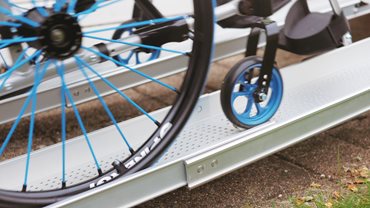Ramp guide
The ramp guide from Mobilex
Which ramp for what?
The choice of the right ramp generally depends on the particular use, the height of the obstacle, the feasible incline and the necessary load on the ramp.
Generally, the following apply to inclines in the private sector:
- For self-propelled vehicles = approx. 6 % incline.
- For strong self-propelled vehicles = approx. 6 - 10 % incline
- One is pushed by a weaker person = up to approx. 12%.
- One is pushed by a strong person = up to approx. max. 20%.
- For electrically driven wheelchairs or scooters = up to max. 20%.
(Here, however, the manufacturer's specifications also apply)
Ramps in the public sector and in rented housing must always be designed in accordance with DIN 18040-1/2 with a maximum gradient of 6%. For larger inclines of 8% or more, an anti-tip device should be used as well as a safety belt. In addition, a low set tread plate can bump.
Calculation of the correct length of the ramp and the incline
Which incline in % should the ramp have and which length of the ramp results then for the optimal use?
We start from the standard and calculate the following length of the ramp for a step with 18 cm height and a 6% incline with the following formula:
Height(m) * 100/ Incline(%) = Length (m).
Now we want to calculate the incline with an existing ramp, whose length we know, with the following formula:
Height(m) * 100/ Length (m) = Incline in %.
As a last variant we want to calculate the height of the obstacle with the already calculated values for control. For this we use the following
Incline in % * Length (m) / 100 = Height (m)
These calculations result in the following empirical values, which are shown here in tabular form for rough orientation:
|
Ramp length |
Height incline 6% |
Height incline 12% |
Height incline 20% |
|
90 cm |
5 cm |
11 cm |
18 cm |
|
110 cm |
7 cm |
13 cm |
22 cm |
|
150 cm |
9 cm |
18 cm |
30 cm |
|
180 cm |
11 cm |
22 cm |
36 cm |
|
210 cm |
13 cm |
25 cm |
42 cm |
|
240 cm |
14 cm |
29 cm |
48 cm |
|
300 cm |
18 cm |
36 cm |
60 cm |
Rule of thumb
There is also a rule of thumb for calculating the maximum inclines and heights or lengths: We assume a 20% incline and can always divide the length of the ramp by 5 to get the maximum height of the obstacle or multiply by 5 if we already have the height to get the required ramp length.
For 10% incline, divide or multiply by 10.
For 5% incline, divide or multiply by 20.
This way, we can always quickly perform the first calculation without a formula.
Example: If the step height is 20 cm, multiply by 5, = ramp length 100 cm at selected 20% gradient. If the incline is 5% and the step height is 20 cm, multiply by 20 and the result is a length of 400 cm = 4.00m.
Material
All Mobilex ramps are made of aluminum. Aluminum is a light metal, so all ramps are still easy to transport and weigh relatively little. In addition, it has a high load-bearing capacity, which in combination makes it an ideal material to produce ramps. Aluminum is therefore also used in the aerospace and automotive industries. 1 cubic meter of aluminum weighs 2.7t, while a cubic meter of steel weighs 8.0t. Only carbon or carbon weighs significantly less with 1.8t of the cubic meter but is again significantly more expensive in the material price.
Ramp types from Mobilex
At Mobilex we distinguish between the following types of ramps:
A) Suitcase ramps: foldable or telescopic (channel or rail ramps).
- CH ramps (length 180, load 300 kg, friction)
- TR ramps (length 150, 210,300, load 225 kg, friction)
- LR ramps (length 150, 210, load 180 kg, friction)
- TM ramps (length 55, 150, 210, 300, load 250-300 kg, perforated)
- SF ramps (length 40, 90, 120, 150, load 300 kg, friction)
- SC ramps (length 45, 60, 90, 120, 150, 180, load 300 kg, ribbed)
- DF ramps (length 180, 240, 300, load 300 kg, friction)
- SR ramps (length 180, 240, load 300 kg, friction)
B) Threshold ramps (aluminum and rubber)
- Rubber ramps (width 70, 90, 100, heights from 4 mm - 72 mm)
- DS ramps (dimensions 40x76, 40x25, 21x76 load 350 kg)
C) Terrace ramps
- T-ramps (dimensions LxW 60x80, 75x80, 125x80, heights 5-28 cm, load 225 kg, ribbed)
- TSR ramps (dimensions LxW 130x80, 140x80, heights 15-22,5 cm, load 225 kg, grained)
